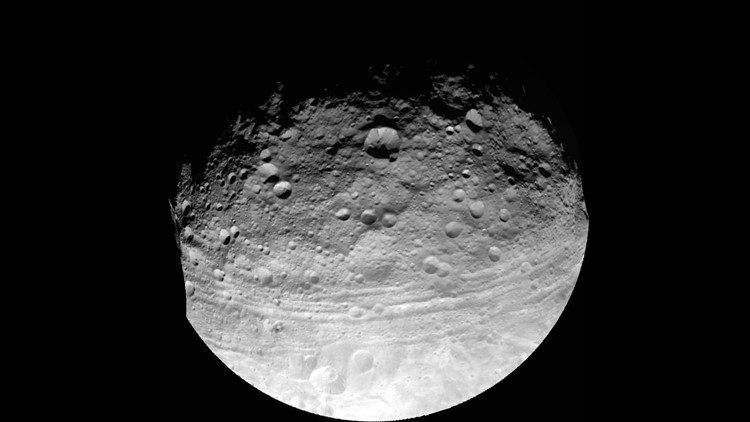By Amanda Barnett, CNN
(CNN) — Vesta, the second-largest object in our solar system’s asteroid belt, is a protoplanet, according to research released Thursday. Scientists reviewed data from the Dawn spacecraft orbiting Vesta and concluded that Vesta is protoplanet that survived numerous collisions with other space rocks since it formed more than 4.5 billion years ago.
“Dawn’s mission at Vesta has been a spectacular success. It’s transformed Vesta from a fuzzy orb into a planetary body,” said Carol Raymond, the deputy principal investigator for Dawn at NASA’s Jet Propulsion Laboratory in Pasadena, California.
Becoming a protoplanet is an upgrade from Vesta’s previous designation as an asteroid or minor planet. It means Vesta’s structure shows it has a dense, layered body and orbits the sun, like the Earth and other rocky planets. Vesta didn’t quite make it to full-fledged planet, but Raymond said it’s more like a planet than an asteroid.
“Vesta’s history appears to be more similar to rocky, terrestrial planets – Mars, Mercury and the Earth’s moon – than to its larger sibling, the dwarf planet Ceres,” Raymond said at a briefing announcing new research data on Vesta.
According to NASA, a large rocky body orbiting the sun is called an asteroid or minor planet. Much smaller particles in orbit about the sun are referred to as meteoroids. Protoplanets share more of the materials and structure of planets like Earth, Mercury and Mars, but something interrupted their development, and they never quite made it to planetary status.
Vesta is between Mars and Jupiter in our solar system’s main asteroid belt. It is about as long as Arizona: 359 by 348 by 285 miles (about 578 by 560 by 458 kilometers). There are about 440,000 known asteroids in the region, but scientists say there could be millions that haven’t been discovered. Most are very small.
Researchers also confirmed that Vesta is the “parent” of a common type of meteorite found on Earth. Called howardite-eucrite-diogenites, or HEDs, they make up about 6% of the meteorites that fall to Earth. Scientists think these meteorites come from a giant impact basin at Vesta’s South Pole called Rheasilvia. That area also is believed to be where small asteroids, called Vestoids, come from.
Images and data from Dawn are giving researchers details about the shape and composition of Vesta. They say it is covered with impact craters, steep slopes and large troughs.
“Vesta has a concentration of mass at its center proving that it is a differentiated body with an iron core, a silicate mantle and a less dense basaltic crust, the same as Mercury and Mars, the Earth and the moon,” Raymond said.
Dawn also has given scientists a much better look at the Rheasilvia basin. Data show that it’s a nearly circular impact basin about 310 miles (500 kilometers) in diameter.
“Vesta is special because it survived the intense collisional environment of the main asteroid belt for billions of years allowing us to interrogate a key witness to the events at the very beginning of the solar system,” Raymond added. “We believe Vesta is the only intact member of a family of similar bodies that have since perished.”
Earlier research from Dawn gave the most detailed information to date about the surface temperature of any asteroid visited by a spacecraft. Researchers reported earlier that data show Vesta’s temperatures range from minus-10 degrees Fahrenheit (minus-23 degrees Celsius) in its sunny spots to minus-150 degrees Fahrenheit (minus-100 degrees Celsius) in the shadows.
The Dawn space probe, carrying a visible light camera, a visible and infrared mapping spectrometer, and a gamma ray and neutron spectrometer, was launched from Cape Canaveral, Florida, on September 27, 2007. After it finishes exploring Vesta, it will travel to the dwarf planet Ceres in February 2015.
Ceres, the largest object in the asteroid belt, is about the size of Texas(606 by 565 miles, or 975 by 909 kilometers). Astronomers think water ice may be buried under Ceres’ crust and estimate that if Ceres is composed of 25% water, it may have more water than all the fresh water on Earth. But if it does have all that water, it’s likely to be frozen in Ceres’ mantle.



